by Lacey Cooke | Sep 18, 2018 | 01 What's New, DNA, MyHeritage |
Since 2016, MyHeritage DNA has offered the ability to transfer your DNA data from other DNA companies for free, and now they’ve expanded that offering to include Living DNA and 23andMe v5. With this news comes additional changes to their free upload offerings, so get your data transferred now to take advantage of all their tools.
Our friends at MyHeritage.com, one of the Genealogy Giants and a sponsor of the free Genealogy Gems Podcast, recently made the announcements we are sharing below.
MyHeritage DNA news you can use
1. Transfer your DNA results from Living DNA and 23andMe v5.
“We’re happy to announce another industry first from MyHeritage! We now support the upload of 23andMe v5 and Living DNA data files, in addition to supporting data uploads from all major DNA testing services, including Ancestry, 23andMe (prior to V5) and Family Tree DNA (Family Finder).
Since 2016, MyHeritage has allowed users who have already tested their DNA to upload their DNA data from Ancestry, 23andMe and Family Tree DNA. They receive DNA Matches and ethnicity estimates on MyHeritage for free. Our free upload service is a unique benefit not offered by any of these other companies. However, previously MyHeritage did not support the upload of tests based on the chip called GSA (Global Screening Array), now being used by 23andMe (v5), and by Living DNA. Recent improvements to our DNA algorithms now allow us to support DNA data processed on GSA chips, and so we now support uploads of 23andMe v5 and Living DNA data files.
Uploading your DNA data to MyHeritage is fast and simple. For users that upload now, we offer full access to DNA Matching, Ethnicity Estimates, our industry-leading chromosome browser, and more, for FREE.”
Click below to upload your DNA now for FREE!
The announcement continues:
“If you manage additional DNA kits for some of your relatives, and you have their permission, upload their DNA data too, and MyHeritage will let you associate the data with the respective individuals on your family tree. DNA data uploaded to MyHeritage is completely private and secure. Only you can see the DNA data you upload.”
2. Upcoming Changes to Tools Access
The announcement goes on to discuss a few changes you can expect with their free upload service:
“As of December 1, 2018, our policy regarding DNA uploads will change: DNA Matching will remain free for uploaded DNA data, but unlocking additional DNA features (for example, ethnicity estimate, chromosome browser, and some others) will require an extra payment for DNA files uploaded after this date. We will announce the full details of the new policy once it is finalized, closer to December 1st. All DNA data that was uploaded to MyHeritage in the past, and all DNA data that is uploaded now and prior to December 1, 2018, will continue to enjoy full access to all DNA features for free. These uploads will be grandfathered in and will remain free.
So, don’t delay, and upload your DNA data to MyHeritage now, while all the DNA features are free (and they will remain free for you). If you have tested with 23andMe (any versions including v5) or Living DNA, you’re in luck, and you can now upload this data to MyHeritage too. You can also upload DNA data from Ancestry and Family Tree DNA’s Family Finder test. Instructions for exporting your data and uploading it to MyHeritage are provided on our upload page.”
Lacey has been working with Genealogy Gems since the company’s inception in 2007. Now, as the full-time manager of Genealogy Gems, she creates the free weekly newsletter, writes blogs, coordinates live events, and collaborates on new product development. No stranger to working with dead people, Lacey holds a degree in Forensic Anthropology, and is passionate about criminal justice and investigative techniques. She is the proud dog mom of Renly the corgi.
Disclosure: This article contains affiliate links and Genealogy Gems will be compensated if you make a purchase after clicking on these links (at no additional cost to you). Thank you for supporting Genealogy Gems!
by Diahan Southard | Jan 20, 2018 | 01 What's New, DNA, MyHeritage |
We have a MyHeritage DNA matching update! Not only has MyHeritage DNA released a much better matching algorithm, the company that lets you upload your DNA for free has also introduced a chromosome browser. Your DNA Guide Diahan Southard shares the good news—and a quick introduction to her favorite matching tools on MyHeritage DNA.
In my first job as a grocery store clerk, I learned that most customer service issues can be solved if you listen carefully to the customer and do all you can to make it right. This is what MyHeritage has done.
For months after the launch of their in-house DNA testing product in the fall of 2016, their DNA matching algorithm had problems. Even a year later, there were concerning reports of discrepancies between the match lists of parents and children. And yet, the genetic genealogy community was patient—because MyHeritage had so far delivered on every promise they had made to the community. They had delivered a competitive origins (ethnicity) product, adopted a stringent privacy policy, and let everyone upload their DNA for free.
MyHeritage DNA matching update
Now in January of 2018, all that patience has paid off. MyHeritage has updated its matching algorithm and recalibrated all the DNA matches in their system. The result is a much more robust depiction of our relationships with others in the database. Most users are seeing a dramatic increase in the total number of matches, and a significant decrease in the number of false positives, or matches that are on your match list but shouldn’t be.
Additionally, to the delight of many genetic genealogists, MyHeritage has launched a chromosome browser. This tool allows you to see the locations on the DNA that are shared with your match. Many genetic genealogists like to use this tool to help them visualize the shared DNA, and group their DNA matches.
Now that the matching algorithm has improved, I’d like to recommend three great tools you should be using at MyHeritage to help you identify your genetic matches. Yes, one of them is the chromosome browser–but take a look at these others, too. And take note: you won’t find these exact tools at AncestryDNA.
Tool #1: List of possible relationships for your genetic matches
In a recent blog post, I described how you can narrow down your possible relationships to your genetic matches by comparing your total shared DNA to a table developed by genetic genealogy experts. MyHeritage DNA simplifies that process for you with a customized chart for each of your genetic matches. Each chart visually shows you all possible relationships, even taking into account factors like your age and gender.
To access the chart, log in to your MyHeritage account. Under the DNA tab, select “Genetic Matches.” Then click on the little question mark icon next to the relationship suggestions:
Then you’ll see a chart that’s been customized for this relationship by highlighting all your possible relationships to this genetic match:
Tool #2: Longest piece of shared DNA with your genetic matches
In addition to the range of possibilities above, you can also be misled by the total amount of DNA you share with your genetic matches. Yes, you might actually be third cousins. But if your ancestors lived in a community that intermarried a lot because they were isolated geographically or culturally, you might also just share a lot of common DNA. You might be sixth cousins three times over.
The size of the biggest piece of DNA you share with a genetic match is really important for puzzling this out. Let’s say two of your genetic matches each share 30 centimorgans of DNA with you. Both are predicted to be your fourth cousins, but one person’s longest shared piece of DNA is 18 centimorgans long, and the other’s is 9 centimorgans long. The closer match–the one you should pursue first–is the one that shares the longest piece of DNA.
At MyHeritage DNA, you can sort your list of genetic matches by longest shared segment. At the top of your list, under the “All” drop-down menu, select “Largest Segment.” You may see your match list rearrange itself (this is a clue that the total shared DNA doesn’t tell you the whole story about genetic relatedness):
Then, click on your top genetic matches to see more detail about that longest segment:
Tool #3: NEW Chromosome browser
The new chromosome browser at MyHeritage is what they’re calling an “initial release” or first draft that “will be enhanced further soon.” It’s currently embedded in each of your individual match pages. That way, you can compare what areas of genetic material you and each of your matches have in common.
“It’s a free feature that can be used by all users on MyHeritage who have taken the DNA test or uploaded DNA data,” says a company press release. “It shows the shared segments between you and a DNA Match in purple. When you hover your mouse over any shared segment you can see the genomic position of the shared segment, the size of the segment, and the number of SNPs there. Grey segments are not shared with the DNA Match and crisscrossed sections were not analyzed due to the lack of SNPs in those regions.”
I’ll be back soon with more tips and tutorials on getting the most out of the new MyHeritage chromosome browser. I just wanted to alert you that it’s there—one more valuable tool in the MyHeritage DNA matching toolbox.
Advanced DNA tools for family history research
If you’re ready to get more genealogy information out of your DNA testing experience, consider whether Diahan’s Advanced DNA Bundle might be a good investment for you. These laminated guides are available singly (click on individual titles below) or as a value-priced bundle and can help you with very specific “next steps:”
- Gedmatch: A Next Step for Your Autosomal DNA Test. Gedmatch is a third‐party tool for use by genetic genealogists seeking to advance their knowledge of their autosomal DNA test. This guide navigates you through the myriad of options and point out only the best tools for your genetic genealogy research.
- Organizing Your DNA Matches. With millions of people now in the possession of a DNA test–and most with match lists in the thousands–many are wondering how to keep track of all this data and apply it to their family history. This guide provides the foundation for managing DNA matches and correspondence, and for working with forms, spreadsheets, and 3rd party tools.
- Next Steps: Working With Your Autosomal DNA Matches. This guide outlines what to do next to maximize the power of DNA testing in genealogy. With this guide in hand, genealogists will be prepared to take their DNA testing experience to the next level and make new discoveries about their ancestors and heritage.
Disclosure: This article contains affiliate links and Genealogy Gems will be compensated if you make a purchase after clicking on these links (at no additional cost to you). Thank you for supporting Genealogy Gems!
Your DNA Guide
Diahan Southard is Your DNA Guide here at Genealogy Gems! She has worked with the Sorenson Molecular Genealogy Foundation, and has been in the genetic genealogy industry since it has been an industry. She holds a degree in Microbiology and her creative side helps her break the science up into delicious bite-sized pieces for you. She’s the author of our DNA guides Getting Started: Genetics for Genealogists, and Y Chromosome DNA for Genealogists (click STORE in the menu above)
by Lisa Cooke | Feb 13, 2017 | 01 What's New, DNA |
The genetic genealogy community has a crush. A big one. Everyone is talking about it. “It has such great features,” says one. “It has a chromosome browser!” exclaims another. “It’s FREE!” they all shout. What’s all the hype about? GEDmatch.
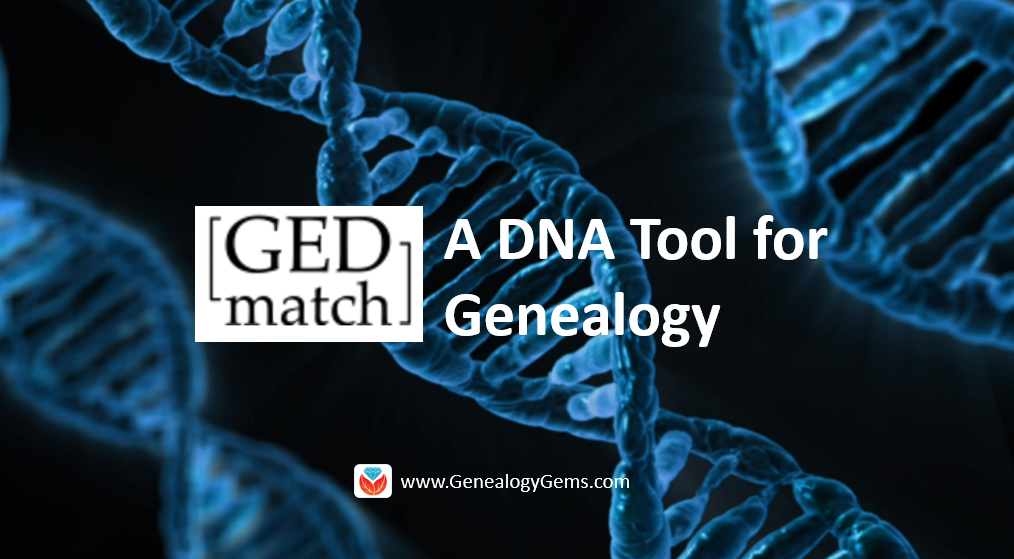
GEDmatch is a mostly free online tool where anyone with autosomal DNA test results from 23andMe, FTDNA, and AncestryDNA can meet and share information. All you need to do is download your data from your testing company and upload it into your newly created GEDmatch account.
GEDmatch Set-up
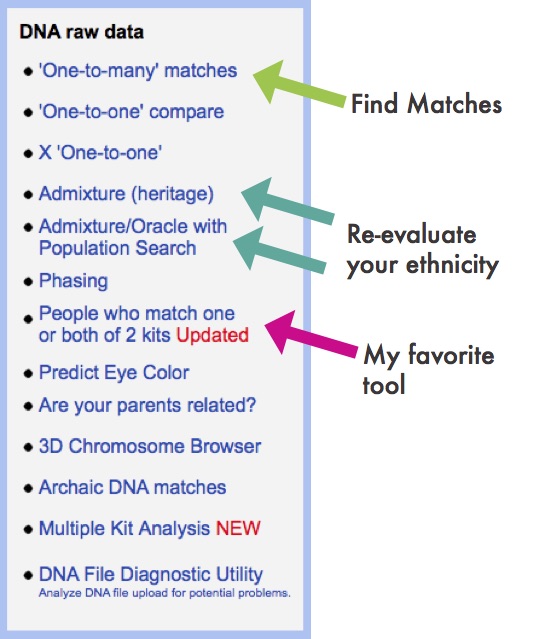 GEDmatch is set up just like your testing company and provides two kinds of reports: ethnicity results and a match list. Remember, ethnicity results, meaning those pie charts that report you are 15% Italian and 32% Irish, are based on two factors: a reference population and fancy math. GEDmatch has gathered data from multiple academic sources to provide you with several different iterations of ethnicity reports. This is like getting a second (and third and fourth, etc) opinion on a science that is still emerging. It is a fun exercise, but will likely not impact your genealogy research very much.
GEDmatch is set up just like your testing company and provides two kinds of reports: ethnicity results and a match list. Remember, ethnicity results, meaning those pie charts that report you are 15% Italian and 32% Irish, are based on two factors: a reference population and fancy math. GEDmatch has gathered data from multiple academic sources to provide you with several different iterations of ethnicity reports. This is like getting a second (and third and fourth, etc) opinion on a science that is still emerging. It is a fun exercise, but will likely not impact your genealogy research very much.
The more important match list does allow you to see genetic cousins who have tested at other companies. Of course, only those who have downloaded their results and entered them into GEDmatch will show up on your list. This means GEDmatch has the potential to expand your pool of genetic cousins, increasing your chances of finding someone to help you track down that missing ancestor.
Many also flock to GEDmatch because they were tested at AncestryDNA and so do not have access to a chromosome browser. A chromosome browser allows you to visualize the physical locations that you share with someone else (see below). Some find this a helpful tool when analyzing their DNA matches, though in my opinion, it is not essential.
 GEDmatch also has some great genealogy features that let you analyze your pedigree against someone else’s, as well as the ability to search all the pedigree charts in their system so you can look specifically for a descendant of a particular relative. However, even with all of these great features, GEDmatch is still yet another website you have to navigate. With that, there will be a learning curve and certainly some frustration.
GEDmatch also has some great genealogy features that let you analyze your pedigree against someone else’s, as well as the ability to search all the pedigree charts in their system so you can look specifically for a descendant of a particular relative. However, even with all of these great features, GEDmatch is still yet another website you have to navigate. With that, there will be a learning curve and certainly some frustration.
GEDMatch or Not?
So, is it worth it? If you are fairly comfortable with the website where you were tested, and you are feeling both curious and patient, I say go for it!
It’s too much to tell you right this minute how to download your data from your testing site and upload it to GEDmatch, but you’re in luck! I’ve put step-by-step instructions for getting started in a free tutorial on my website at www.yourDNAguide.com/transferring.
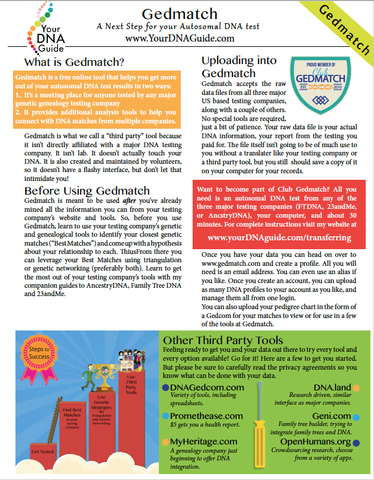
After you’ve done the upload, you may need a little bit more help to navigate the GEDmatch site because there are so many great tools on it. I recently published a GEDmatch Quick Guide, where I have condensed into four pages the most essential features of GEDmatch to get you started and help you make use of this tool for genetic genealogy. Using my guide is an inexpensive and easy way to get a lot more out of a free online resource. I will also be adding more GEDmatch tutorials to my online tutorial series later this fall. Genealogy Gems fans get a nice discount on these! (Click here for that discount).
By the way, have you tried GEDmatch? I would love to hear about your experiences. You can email me at guide@yourDNAguide.com.
DNA QUICK GUIDE BUNDLES
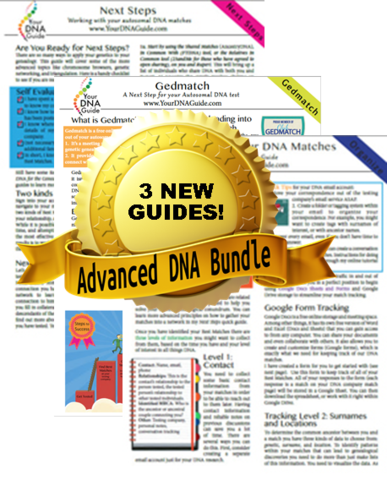
Advanced DNA Quick Guide Bundle by Diahan Southard which includes:
- GEDmatch: A Next Step for your Autosomal DNA Test
- Organizing Your DNA Matches: A Companion Guide
- Next Steps: Working with Your Autosomal DNA Matches
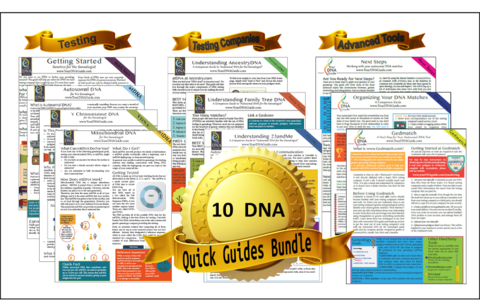
SUPER DNA Quick Guide Bundle by Diahan Southard with ALL 10 Guides
- Getting Started: Genetics for the Genealogist
- Autosomal DNA for the Genealogist
- Mitochondrial DNA for the Genealogist
- Y Chromosome DNA for the Genealogist
and Testing Companies:
- Understanding Ancestry: A Companion Guide to Autosomal DNA for the Genealogist
- Understanding Family Tree DNA: A Companion Guide to Autosomal DNA for the Genealogist
- Understanding 23 and Me: A Companion Guide to Autosomal DNA for the Genealogist
and Advanced Tools
- Next Steps: Working With Your Autosomal DNA Matches
- Organzing Your DNA Matches
- GEDmatch: A Next Step for Your Autosomal DNA Test


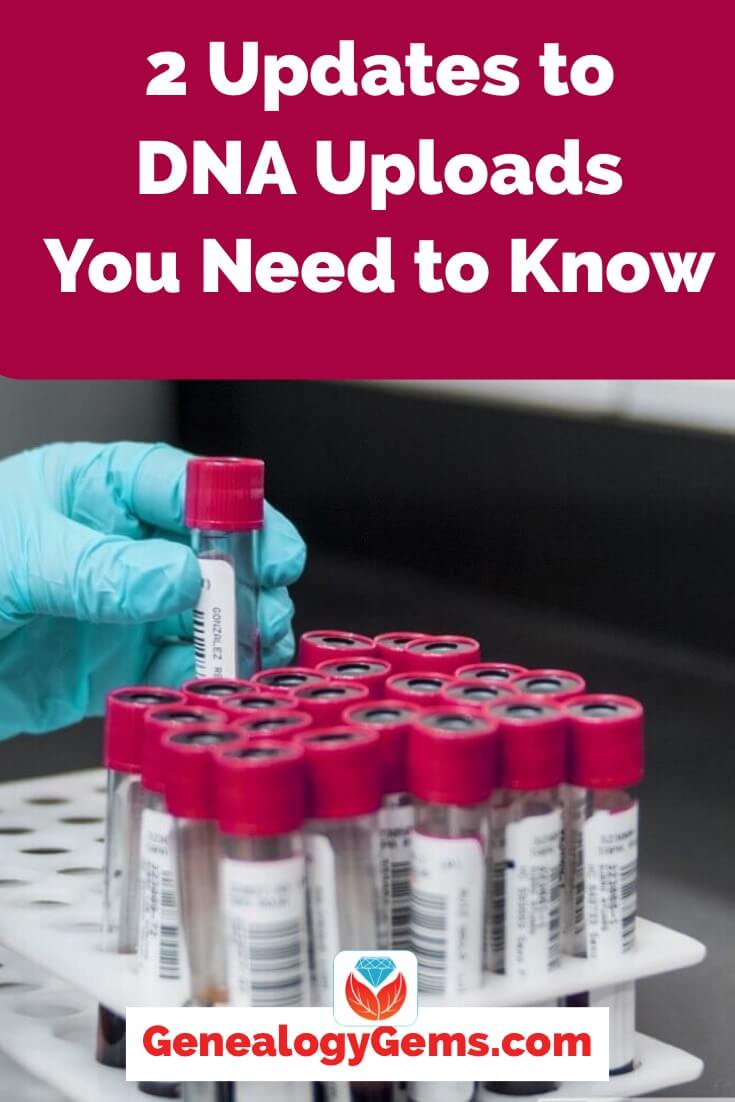
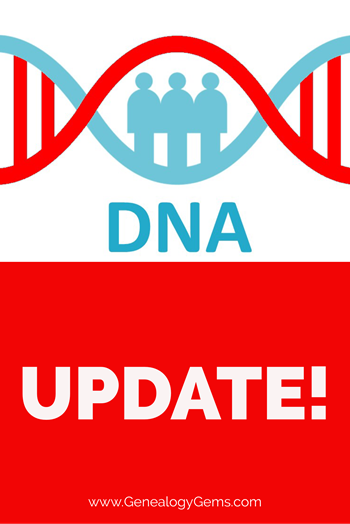

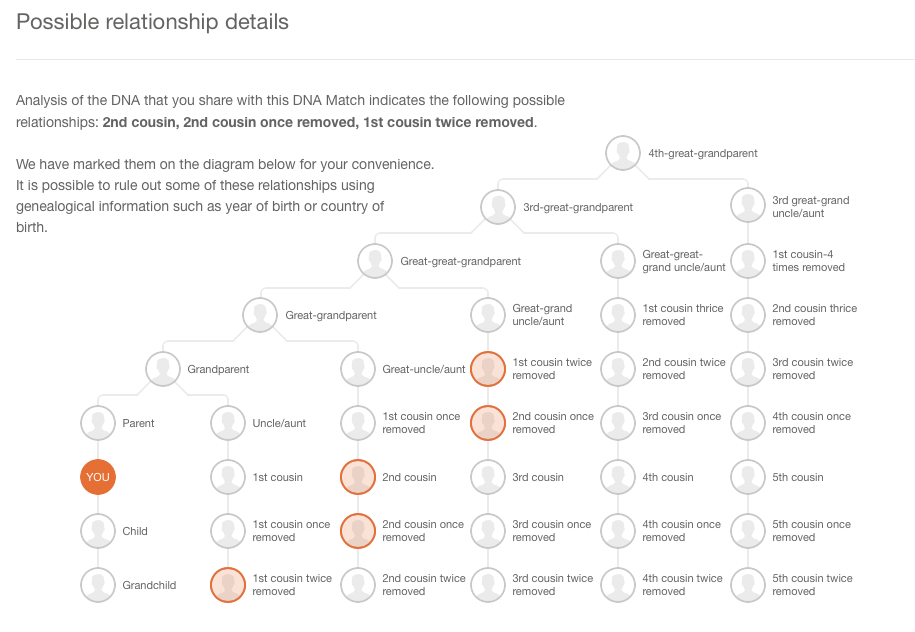
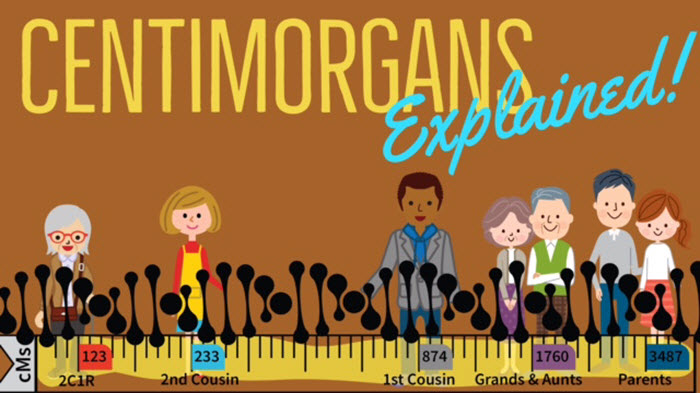


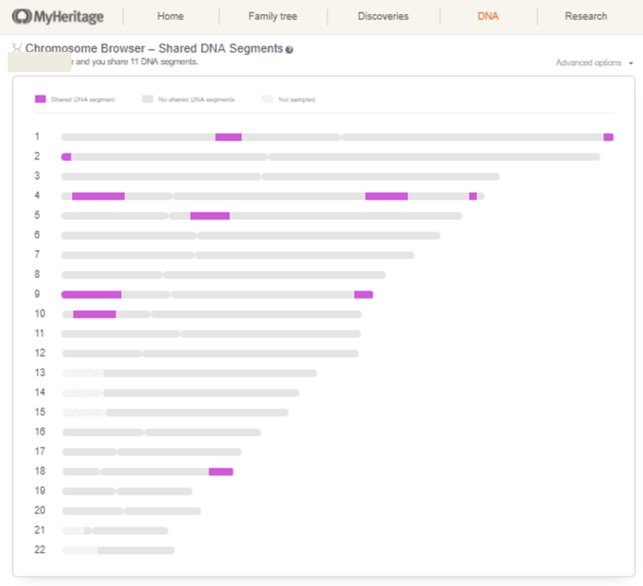



 GEDmatch is set up just like your testing company and provides two kinds of reports: ethnicity results and a match list. Remember, ethnicity results, meaning those pie charts that report you are 15% Italian and 32% Irish, are based on two factors: a reference population and fancy math. GEDmatch has gathered data from multiple academic sources to provide you with several different iterations of ethnicity reports. This is like getting a second (and third and fourth, etc) opinion on a science that is still emerging. It is a fun exercise, but will likely not impact your genealogy research very much.
GEDmatch is set up just like your testing company and provides two kinds of reports: ethnicity results and a match list. Remember, ethnicity results, meaning those pie charts that report you are 15% Italian and 32% Irish, are based on two factors: a reference population and fancy math. GEDmatch has gathered data from multiple academic sources to provide you with several different iterations of ethnicity reports. This is like getting a second (and third and fourth, etc) opinion on a science that is still emerging. It is a fun exercise, but will likely not impact your genealogy research very much. GEDmatch also has some great genealogy features that let you analyze your pedigree against someone else’s, as well as the ability to search all the pedigree charts in their system so you can look specifically for a descendant of a particular relative. However, even with all of these great features, GEDmatch is still yet another website you have to navigate. With that, there will be a learning curve and certainly some frustration.
GEDmatch also has some great genealogy features that let you analyze your pedigree against someone else’s, as well as the ability to search all the pedigree charts in their system so you can look specifically for a descendant of a particular relative. However, even with all of these great features, GEDmatch is still yet another website you have to navigate. With that, there will be a learning curve and certainly some frustration.




